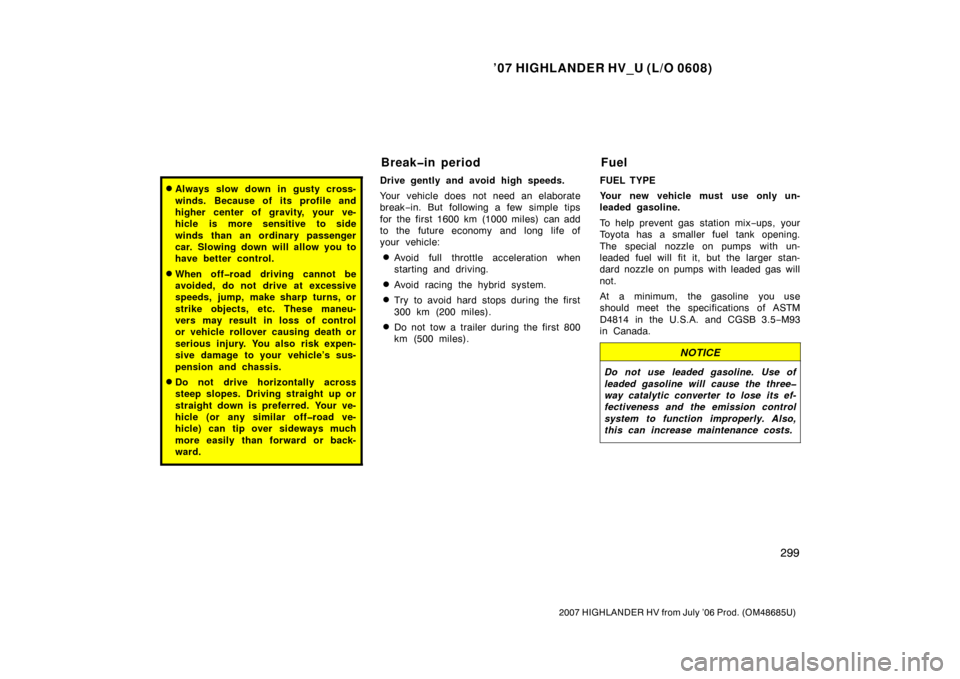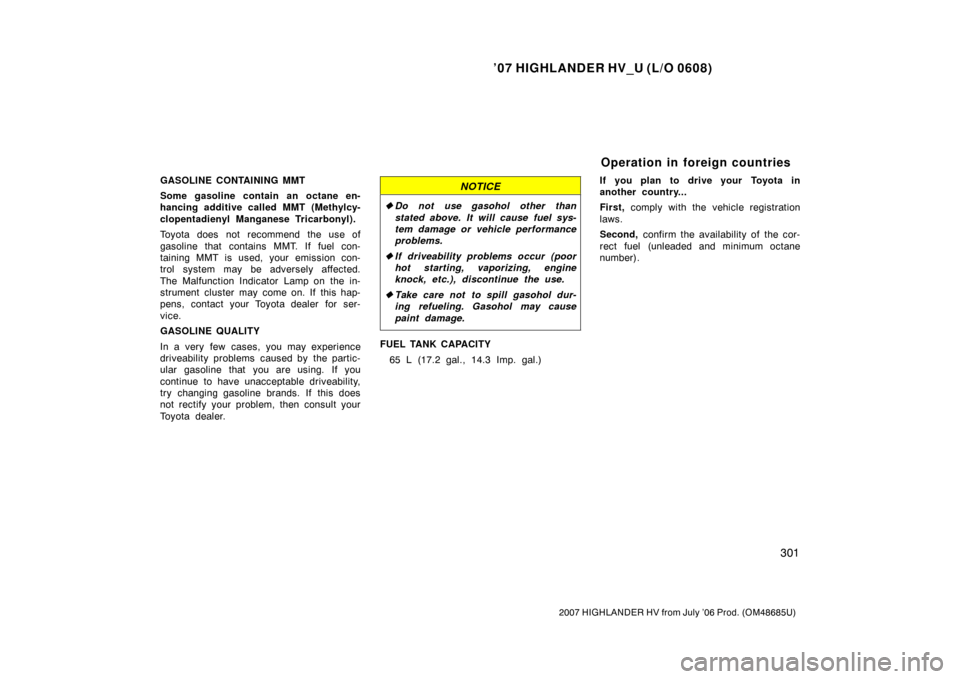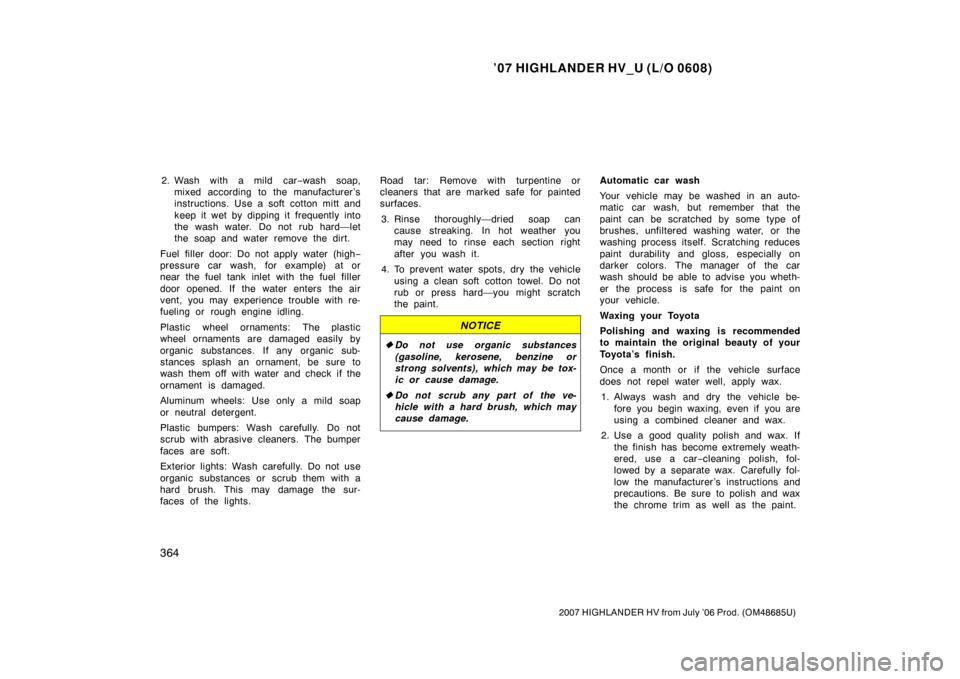Page 311 of 436

’07 HIGHLANDER HV_U (L/O 0608)
299
2007 HIGHLANDER HV from July ’06 Prod. (OM48685U)
�Always slow down in gusty cross-
winds. Because of its profile and
higher center of gravity, your ve-
hicle is more sensitive to side
winds than an ordinary passenger
car. Slowing down will allow you to
have better control.
�When off�road driving cannot be
avoided, do not drive at excessive
speeds, jump, make sharp turns, or
strike objects, etc. These maneu-
vers may result in loss of control
or vehicle rollover causing death or
serious injury. You also risk expen-
sive damage to your vehicle’s sus-
pension and chassis.
�Do not drive horizontally across
steep slopes. Driving straight up or
straight down is preferred. Your ve-
hicle (or any similar off�road ve-
hicle) can tip over sideways much
more easily than forward or back-
ward.
Drive gently and avoid high speeds.
Your vehicle does not need an elaborate
break−in. But following a few simple tips
for the first 1600 km (1000 miles) can add
to the future economy and long life of
your vehicle:
�Avoid full throttle acceleration when
starting and driving.
�Avoid racing the hybrid system.
�Try to avoid hard stops during the first
300 km (200 miles).
�Do not tow a trailer during the first 800
km (500 miles). FUEL TYPE
Your new vehicle must use only un-
leaded gasoline.
To help prevent gas station mix
−ups, your
Toyota has a smaller fuel tank opening.
The special nozzle on pumps with un-
leaded fuel will fit it, but the larger stan-
dard nozzle on pumps with leaded gas will
not.
At a minimum, the gasoline you use
should meet the specifications of ASTM
D4814 in the U.S.A. and CGSB 3.5 −M93
in Canada.
NOTICE
Do not use leaded gasoline. Use of
leaded gasoline will cause the three�
way catalytic converter to lose its ef-
fectiveness and the emission control
system to function improperly. Also,
this can increase maintenance costs.
Break�in period Fuel
Page 313 of 436

’07 HIGHLANDER HV_U (L/O 0608)
301
2007 HIGHLANDER HV from July ’06 Prod. (OM48685U)
GASOLINE CONTAINING MMT
Some gasoline contain an octane en-
hancing additive called MMT (Methylcy-
clopentadienyl Manganese Tricarbonyl).
Toyota does not recommend the use of
gasoline that contains MMT. If fuel con-
taining MMT is used, your emission con-
trol system may be adversely affected.
The Malfunction Indicator Lamp on the in-
strument cluster may come on. If this hap-
pens, contact your Toyota dealer for ser-
vice.
GASOLINE QUALITY
In a very few cases, you may experience
driveability problems caused by the partic-
ular gasoline that you are using. If you
continue to have unacceptable driveability,
try changing gasoline brands. If this does
not rectify your problem, then consult your
Toyota dealer.NOTICE
�Do not use gasohol other than
stated above. It will cause fuel sys-
tem damage or vehicle performance
problems.
� If driveab ility problems occur (poor
hot starting, vaporizing, engine
knock, etc.), discontinue the use.
� Take care not to spill gasohol dur-
ing refueling. Gasohol may cause
paint damage.
FUEL TANK CAPACITY
65 L (17.2 gal., 14.3 Imp. gal.) If you plan to drive your Toyota in
another country...
First,
comply with the vehicle registration
laws.
Second, confirm the availability of the cor-
rect fuel (unleaded and minimum octane
number).
Operation in foreign countries
Page 376 of 436

’07 HIGHLANDER HV_U (L/O 0608)
364
2007 HIGHLANDER HV from July ’06 Prod. (OM48685U)
2. Wash with a mild car−wash soap,
mixed according to the manufacturer ’s
instructions. Use a soft cotton mitt and
keep it wet by dipping it frequently into
the wash water. Do not rub hard—let
the soap and water remove the dirt.
Fuel filler door: Do not apply water (high −
pressure car wash, for example) at or
near the fuel tank inlet with the fuel filler
door opened. If the water enters the air
vent, you may experience trouble with re-
fueling or rough engine idling.
Plastic wheel ornaments: The plastic
wheel ornaments are damaged easily by
organic substances. If any organic sub-
stances splash an ornament, be sure to
wash them off with water and check if the
ornament is damaged.
Aluminum wheels: Use only a mild soap
or neutral detergent.
Plastic bumpers: Wash carefully. Do not
scrub with abrasive cleaners. The bumper
faces are soft.
Exterior lights: Wash carefully. Do not use
organic substances or scrub them with a
hard brush. This may damage the sur-
faces of the lights. Road tar: Remove with turpentine or
cleaners that are marked safe for painted
surfaces.
3. Rinse thoroughly—dried soap can cause streaking. In hot weather you
may need to rinse each section right
after you wash it.
4. To prevent water spots, dry the vehicle using a clean soft cotton towel. Do not
rub or press hard—you might scratch
the paint.
NOTICE
�Do not use organic substances
(gasoline, kerosene, benzine or
strong solvents), which may be tox-
ic or cause damage.
� Do not scrub any part of the ve-
hicle with a hard brush, which may
cause damage.
Automatic car wash
Your vehicle may be washed in an auto-
matic car wash, but remember that the
paint can be scratched by some type of
brushes, unfiltered washing water, or the
washing process itself. Scratching reduces
paint durability and gloss, especially on
darker colors. The manager of the car
wash should be able to advise you wheth-
er the process is safe for the paint on
your vehicle.
Waxing your Toyota
Polishing and waxing is recommended
to maintain the original beauty of your
Toyota’s finish.
Once a month or if the vehicle surface
does not repel water well, apply wax.
1. Always wash and dry the vehicle be- fore you begin waxing, even if you are
using a combined cleaner and wax.
2. Use a good quality polish and wax. If the finish has become extremely weath-
ered, use a car −cleaning polish, fol-
lowed by a separate wax. Carefully fol-
low the manufacturer ’s instructions and
precautions. Be sure to polish and wax
the chrome trim as well as the paint.